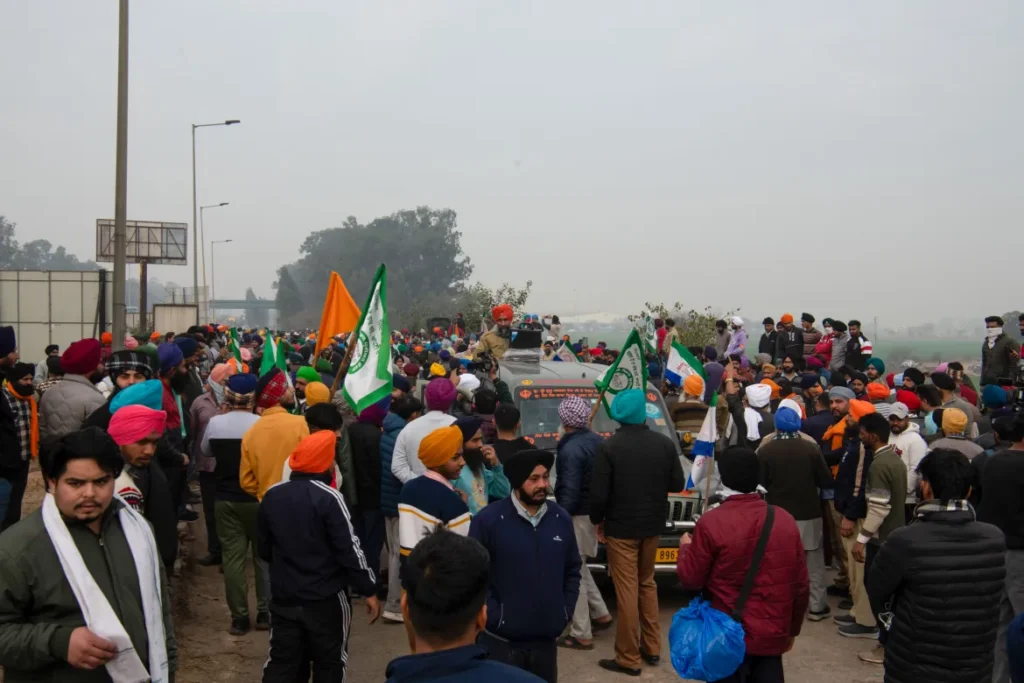After their victory against the controversial agricultural reforms in India, the farmers at the national level started marching from different parts of Punjab to Delhi yesterday under the slogan ‘Dili Chalo.’ However, the police on the borders of Haryana tear-gassed them. Shelling, lathi charge, and massive roadblocks were also encountered.
When the farmers used tractors to clear the obstacles to move forward, the police fired tear gas shells and lathi-charged them with the help of drones. Hindi Correspondent Abhinav Goyal reports from the Punjab-Haryana border that the second day of farmers’ protests at the Shambhu border between Punjab and Haryana is calmer than Tuesday’s.
Haryana began intermittently firing tear gas shells at around 11 am on Wednesday. The scale of the tear gas shelling operation on Tuesday was massive. Now, to avoid tear gas, farmers have wet jute sacks. At the same time, farmers are not breaking barriers like yesterday. Police and paramilitary forces are deployed on the Haryana side, and farmers are flying kites on the Punjab side while many are still here.
The BBC’s correspondent Keerti Dubey from the Sanghu border of Delhi and Haryana has said that the Delhi Police has made strict security arrangements and has installed multi-layer barricading. The blocks are sealed with cement so that they cannot be removed even by tractors.
A barbed wire net has been laid along it. Meanwhile, there is a heavy traffic jam at the border. Better arrangements have been made compared to the year 2020. A police official said on condition of anonymity that ‘last time the administration had no idea that the farmers would come here and sit for so many days. We have an idea this time, so the security arrangements are also being made at the same level. Along with deploying police and rapid action force, drones also do surveillance.
What happened yesterday
Peasant protest, India, photo source GETTY IMAGES. Then again, India’s public authority fixed Delhi’s boundaries on three sides. At the same time, the police on the lines of Punjab and Haryana have lathi-charged the marchers and utilized poisonous gas from drones.
Having failed to negotiate with the public authority beforehand, many ranchers began their walk on Tuesday morning from various parts of Punjab toward the Shambhu line in Haryana. Talks between government authorities and ranchers’ chiefs, which went on until late Monday night in the state capital, Chandigarh, to keep the ranchers’ associations from walking, might have been more productive.
In Punjab’s Fatehgarh Sahib, Hindi journalist Abhino Goyal addressed the ranchers attending the convention. He said that this time, a more significant number of individuals were with them than previously. If the work vehicles are in large numbers, the individuals are in large numbers. When a rancher was told about the obstructions in the way, he said that ranchers know how to eliminate a wide range of impediments, and nobody can prevent them from going to Delhi.
One more rancher said, “They will either accompany their requests or overturn the Modi government because the races are coming.”
What are the requests of ranchers?
In 2020, ranchers set up camp on the Delhi border for over a year, challenging the controversial agrarian change regulation. The drawn-out fights, which left handfuls dead, finished after the public authority consented to cancel the regulations. Presently, the ranchers have again rampaged, as it is commonly said their fundamental requests are yet to be met.
The requests of the ranchers are that. The acquisition of harvests at MSP (Least Help Cost) ought to be ensured, and the public authority ought to give notice of this impact. The report put together by the Swaminathan Commission ought to be carried out. Ranchers ought to be given half of the benefit at the expense of developing the yield.
Advances of ranchers ought to be postponed. The arguments against them during the ranchers’ development should be removed. Under the public authority’s business code, MNREGA, 200 workdays should be provided annually, and the daily compensation should be Rs 700.
Government strategies to stop the walk
The development was one of the most significant challenges for Head of State Narendra Modi’s administration. Two rounds of talks between ranchers’ association chiefs and government clergymen failed to resolve the situation.
Delhi police have sealed borders on three sides of the city to prevent a 2020 situation. Meanwhile, the internet was shut down in Haryana on Tuesday, where barricades were erected to stop the farmers’ march. In response to accusations of farmers blocking traffic on the roads, one man said, ‘You can see we are going sideways. Those who blocked the road- the blame goes to them. We are all innocent. We are responsible.’
Suppose 32 farmer organizations in Punjab were involved in the protest three years ago. In that case, more than 50 unions are involved this time, and more than 200 organizations nationwide are ready to march toward Delhi. After the farmers’ talks failed, Agriculture Minister Arjun Manda told the media that the negotiations with the farmers’ organizations were earnest. The government always wants every problem to be solved through dialogue. We have come here for this purpose as representatives of the Government of India.
He said all such topics were discussed, and we agreed on them. However, some topics had so many related issues that we said we needed to form a committee to find a temporary solution and present our ideas to the committee to see a permanent solution. We are still willing to talk. United Kisan Morcha convener Jagjit Singh Dhaliwal said the meeting was lengthy and that every demand was discussed. He said, “Let me clarify that these were not demands.” These were the promises that the government made to us in different periods. Instead of agreeing to them, the government says it will form a committee.
Read also: General Elections: Jemima Goldsmith X Deletes Post











